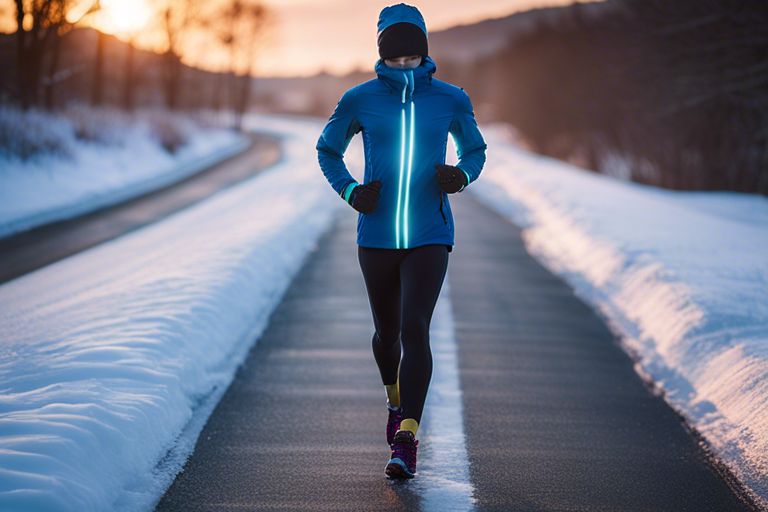As the winter months approach, many outdoor enthusiasts find themselves faced with icy and slippery terrains that can make jogging a challenging and even hazardous activity. In order to safely enjoy your winter runs, it is vital to have the right gear that offers traction, warmth, and protection against the elements. From non-slip running shoes with special grips to thermal running tights and moisture-wicking base layers, this guide will explore the best jogging gear specifically designed to tackle icy terrain. Stay safe, warm, and comfortable while embracing the beauty of winter running with our top recommendations for the best jogging gear to conquer icy terrains.
Key Takeaways:
- Invest in Trail Running Shoes: Opt for shoes with good grip to prevent slipping on icy terrain.
- Layer Up: Wear moisture-wicking base layers to stay dry and insulated during your run.
- Wear Reflective Gear: Ensure you are visible to others, especially in low-light conditions during winter.
- Use Yaktrax or Ice Spikes: Attach these to your shoes for extra traction on icy paths.
- Stay Hydrated: Despite the cold weather, it’s crucial to stay hydrated during your run.
Footwear for Icy Surfaces
Insulated and Waterproof Running Shoes
When jogging in icy terrain, it is crucial to invest in insulated and waterproof running shoes to keep your feet warm and dry. Look for shoes with thermal insulation to retain heat and a waterproof membrane to keep out moisture from snow and slush. These features will not only provide comfort but also protect your feet from the cold and wet conditions, ensuring a safe and enjoyable run.
Traction Devices for Shoes
In addition to proper footwear, traction devices for shoes are important when running on icy surfaces. These devices, such as ice cleats or traction spikes, can be attached to the soles of your shoes to improve grip and stability on slippery terrain. They are especially helpful in preventing slips and falls, reducing the risk of injuries while running in icy conditions.
Before purchasing traction devices, make sure to check the compatibility with your running shoes and the type of terrain you will be running on. Choose a durable and reliable option that provides excellent traction without compromising your running performance. Be mindful of, safety should always come first when jogging in icy weather.
Apparel for Cold Weather Jogging
Thermal and Wind-Resistant Clothing
When taking on icy terrain during winter jogging, it’s important to invest in thermal and wind-resistant clothing to keep warm and shielded from harsh weather conditions. Look for base layers made from materials like merino wool or technical fabrics that wick away moisture to help regulate your body temperature. Additionally, opt for windproof jackets and trousers to protect yourself from cold gusts and maintain comfort throughout your run.
Visibility and Reflective Wear for Safety
Visibility is crucial when jogging in low light conditions or icy terrain. Ensure your safety by wearing reflective gear such as vests, jackets, and accessories with reflective strips. These items will help you stay visible to other road users, reducing the risk of accidents during your winter runs.
Keep in mind, in icy conditions, visibility is not just about being seen but also about seeing your surroundings clearly. Consider wearing a headlamp or carrying a small flashlight to illuminate your path and be aware of any potential hazards. Prioritising visibility and reflective wear is a key aspect of staying safe while jogging in challenging winter weather.
Essential Accessories for Icy Jogging
Gloves and Headwear for Warmth
When jogging in icy terrain, it is crucial to protect your extremities from the biting cold. Invest in a good pair of thermal gloves to keep your hands warm and functional, allowing you to maintain a comfortable grip and dexterity. Additionally, a snug beanie or ear warmer can help retain heat and protect your head from heat loss, ensuring you stay warm and focused during your run.
Hydration Solutions in Cold Conditions
Staying hydrated is necessary even in cold weather, as the body still loses fluids through respiration and sweat. Opt for an insulated water bottle to prevent your liquids from freezing during your run. Alternatively, consider using a hydration backpack with an insulated hose to keep your water supply easily accessible and at a drinkable temperature throughout your icy jog.
Hydration is key to maintaining performance and avoiding dehydration, especially in cold conditions where the risk of overlooking fluid intake is high. By choosing the right hydration solution, you can ensure you stay adequately hydrated and perform at your best on icy terrains.
Personal Safety and Navigation
Electronic Aids and Emergency Gear
When jogging on icy terrain, it is crucial to have the right electronic aids and emergency gear to ensure your safety. Consider carrying a fully charged mobile phone with GPS capabilities, as well as a portable charger for longer runs. In addition, invest in a GPS watch that can track your route and provide assistance in case of an emergency. It is also advisable to carry a small first aid kit, emergency blanket, and whistle for added security.
Tips for Staying Safe on Icy Trails
Staying safe on icy trails requires a combination of preparation and caution. Start by checking the weather forecast and trail conditions before heading out. Wear appropriate footwear with good traction to avoid slipping on the ice. Always tell someone your planned route and estimated return time. Avoid running alone in remote areas, and if possible, take a running buddy with you. It is important to stay alert and adjust your pace to the conditions of the trail.
- Recognising signs of frostbite and hypothermia is crucial for staying safe on icy trails.
The Best Jogging Gear for Icy Terrain
When facing icy terrain, equipping yourself with the right jogging gear is imperative to ensure your safety and comfort. From sturdy ice grips for your shoes to thermal running tights and moisture-wicking base layers, having the appropriate clothing and accessories can make all the difference. Additionally, investing in a headlamp for increased visibility and a lightweight, waterproof jacket can be crucial for those early morning or evening runs on icy paths. By prioritising traction, warmth, visibility, and weather protection, you can enjoy your jogging experience even in challenging winter conditions.
FAQ
Q: What are the necessary features to look for in the best jogging gear for icy terrain?
A: The necessary features to look for in the best jogging gear for icy terrain are excellent traction soles, waterproof and insulated material, reflective elements for visibility, and a secure closure system to keep snow out.
Q: How important is insulation in jogging gear for icy terrain?
A: Insulation is crucial in jogging gear for icy terrain as it helps to keep your feet warm and protected from the cold, preventing frostbite and ensuring comfort during the run.
Q: Why is good traction necessary in jogging gear for icy terrain?
A: Good traction is necessary in jogging gear for icy terrain to prevent slipping and falling on slippery surfaces, providing stability and confidence while running in challenging conditions.
Q: Can reflective elements in jogging gear really make a difference in icy terrain?
A: Yes, reflective elements in jogging gear can make a significant difference in icy terrain by increasing visibility in low light conditions, making you more noticeable to vehicles and other runners for safety.
Q: How should one choose the right size of jogging gear for icy terrain?
A: When choosing the right size of jogging gear for icy terrain, it is recommended to go for a slightly larger size to accommodate thick winter socks for better insulation and comfort without compromising fit and performance.






